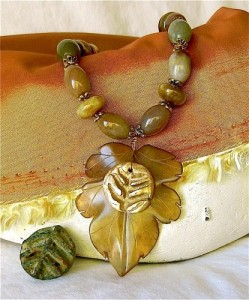The bronze circle that you see overlying the hand carved translucent jade leaf I made from scratch just as we might make a cookie with a face on it for the holidays. The comparison is appropriate, because the bronze ‘cookie’ started as a pinch of clay binder with a lot of bronze powder in it. I rolled the pinch a bit with a rolling pin from the kitchen drawer. But I left it thick enough to allow the ancient bronze stamp seal from Bactria, dating from about three thousand five hundred years ago, to make its impression on my bronze dough.
Then I took my pinched and punched bronze clay to the dehydrator tray and dried it completely. When it was dry, I drilled a small hole in the now more substantial piece, more like a freshly baked cookie with a design punched into it. My bronze impressions will repeat all the ‘accidents’ in crafting the original piece, so the impression of the accidents are in the new piece. From there I smoothed it just a bit around the edges and fired it in the kiln for a few hours. After it cooled I smoothed it with fine grit on my hand tool and it was now solid bronze; the polymers that had bound it together were vaporized in the kiln.
The original stamp seal shown in the photo above is not for sale, but I want to tell you a bit of its story. It is a rather abstract symbol of the spiny plant that was gathered from the wild to make the ritual drink for the religious services of the earliest Zoroastrians, the religion of the Persians. Small communities still exist in Iran, India and Pakistan. I had a friend in Kabul, Afghanistan who was Parsee, who spoke Gujrati and was from Mumbai, India. Parsee was the name for Persian, and the people who followed the religious teachings in the Avesta were called Persians or Parsees.
The spiny plant represented on this stamp seal was the basis of a religious oblation, so the stamp seal might have been carried by one of the Zoroastrian priests or altar servers. In any case the stamp seal certainly made a noticeable impression on the bronze clay that I had pinched and punched into a form just large enough to look as it might have looked had it been made in beeswax or clay in order to seal a clay pouch.
There were no documents at that time, just clay and stone on which to record symbols, as the Bactrians of that time did not have an alphabet or paper.
The bronze impression from my kiln now needed a friendly group of gemstones to hang with. Jade was already popular in Asia in the same time period in which the original bronze stamp seal was created. It was the natural choice. I had bought a bunch of hand carved jade leaves decades ago in Kabul, Afghanistan, each of the leaves unique in the shade of brownish yellow-green nephrite jade from which they were carved. This particular one was perfect for this bronze impression.
As for the completion of the necklace, I collect jade beads and pendants, so I had just the right combination of shades of nephrite jade beads to call out the various natural tints in the pendant leaf on this necklace. The separator beads are also jade in the different shades that the nephrite stones produce.
The caps on the oval shaped beads are antiqued brass, as are the small beads at each end of the necklace. The chain is bronze as is the handmade hook and loop fastener.
Wherever you wear this necklace, whatever you wear with it will mark you as a person of discriminating taste and knowledge of other cultures. For sure, people will ask about the bronze pendant.
Necklace length – 20 inches (51 cm)
Jade and bronze pendant dimensions – 44 mm x 60 mm including bail (1.75 in x 2.4 in)

